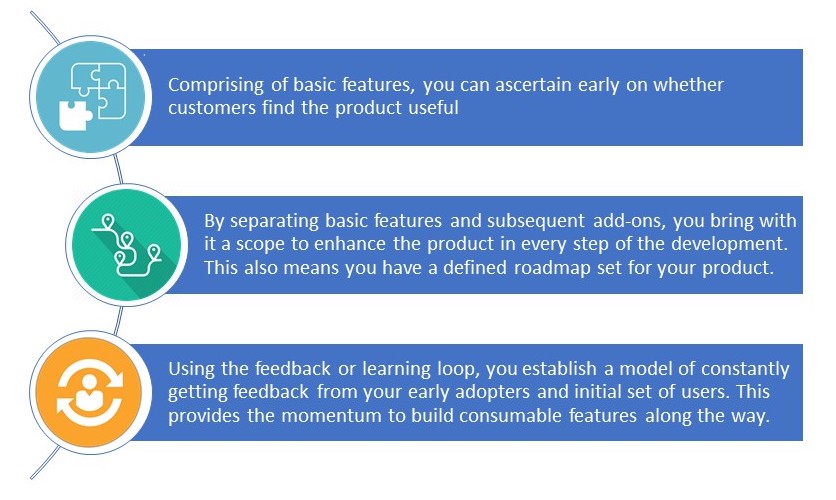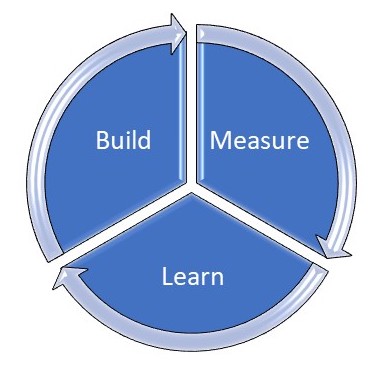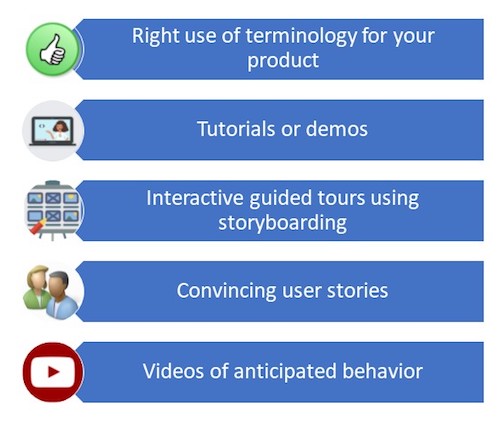Let me introduce the concept of a minimum viable product (MVP) with a glance into history:
Back in 2011, Eric Ries, an American entrepreneur, blogger, and author, released his bestselling book The Lean Startup in which he talked about his experience in building startups. This book not only impacted the whole startup industry, but also introduced concepts including A/B testing, agile principles, minimum viable product and continuous software deployment.
In his book, he defines the MVPas that“version of a new product which allows a team to collect the maximum amount of validated learning about customers with the least effort. The validated learning comes in the form of whether your customers will purchase your product.”
Once you have a vision set for your product, you start breaking it into smaller consumable chunks such as key features and finally realize how they all come together. Your MVP can start off as a very simple solution to the business problem at hand. With the help of user research activities, you can determine how your solution is consumed, what has worked well in the past, what is missing, what features aren’t used, and perhaps what your users don’t like about the product. This gives you first-hand feedback on how usable, intuitive and functionally optimal your solution is.
Characteristics of an MVP
The MVP technique brings with it a set of characteristics that qualify how it fits into the whole startup and entrepreneurial space for building efficient products.

Figure 1: Characteristics of an MVP
How to bring together “Minimum” and “Viable
All of us in the technology space perpetually want all the products that we deliver to be perfect and feature-rich. However, in the chase for the perfect product, we tend to lose focus on the actual business use case at hand, and we attempt to work on a multitude of features. This tends to overload the product as well as lead to many problems at the start. What follows is a series of pitfalls where we find ourselves treating the wounds of a poorly initiated and developed product.

Figure 2: Bringing ‘minimum’ and ‘viable’ features together
Another mistake is how important functions are drilled down to the smallest subset, and its actual consumption becomes a problem for the user. The MVP technique aims at keeping the features at a minimum; however, this does not mean that these features make the product unusable. Breaking functions down to smaller units is fine as long as these units are functional and can be used to solve a particular problem. What’s important is to understand the business scenario at hand, then develop and release features that the user can consume. What iterations you deliver subsequently are additions to an already consumable feature.
For example, think of a simple food delivery solution that you might intend to build. The primary need for a user of this solution is to be able to order food to his doorstep and facilitate easy payment options. You don’t have to think of machine learning use cases in the very first iteration where with every order the app learns your user’s choices. This is something you can consider once you learn with your first iteration what your users think.
In this regard, the viability of your features becomes crucial. You should provide your users with a viable and working product that will allow customers to complete the user journey and achieve their goals. As you keep enhancing your product with more viable features, your product becomes a much more efficient solution for your users.
Remember that the viability is not what you iterate. The viability comes into the picture right from the time you start shortlisting your features. Often, many product leads and experts misconstrue this technique as an iterative process to finally make the product viable. By doing so, you will experience downfalls right from the start. In the process, you can lose many potential users, and the product isn’t what your users need.
Some key iteration aspects to keep in mind when you develop a product using the MVP technique:
- Iterations should make your product go from good to great and not from bad to good.
- With every iteration, you get more user feedback that you can incorporate into your product.
An MVP that brings in both minimum and viable features delivers a foundational experience that is usable, has high utility, and is free of bugs. With that foundation in place, you can constantly iterate the product.
Process steps for an MVP

Figure 3: Process steps for an MVP
When you decide to use the MVP technique, there are some process steps that will help you through this phase.
1. What is the business need and the pulse of the market?
The first step is to identify if there is a need for your product in the market. This will help you determine what your product must provide to fulfill this need. In this process, you can also chart out your long-term goal or vision for your product.
2. Have you narrowed down the key features?
A good way to ensure that your users will have a good experience with the first iteration of your solution is by mapping out user journeys. This provides insight into how you can design the solution in a way that is convenient for users. You must determine who is the core user. At this stage, you will be able to discern what features to prioritize in your MVP, as well as what features to include on your product roadmap that are of lower priority.
3. How unique is your offering?
There are tons of ideas and products floating around in the market. There’s a high chance that these ideas and products are redundant considering the many competitors in the market. The main goal is to develop a product that will attract customers who will eventually use it because of certain things that make it different from the rest. What you need to figure out is the special distinguishing mark that you bring to the table with the MVP you have in mind. There is no dearth of ideas; it’s all about how these ideas can be translated into something usable that can be implemented in a feasible manner. A simple tip here is to think about the apps you use in your daily routine. Why do you go back to using these apps? Why do you carry out your activities using these apps?
4. Is your product stable enough?
Separate the list into the most important features and features that can be done as add-ons after the MVP launch. This step seems very straightforward, but sometimes you might get trapped and end up with a big set of features for the MVP. Review it as much as you can until you come up with a filtered and ordered list based on your knowledge about market priorities and requisites. Once you have prioritized your features, you can now decide what parts can work in tandem. The idea about keeping the minimum and viable together is to ensure that the MVP satisfies both utility and functional integrity.
5. Who are your stakeholders?
Based on the features you plan to bring together in your MVP, you now must decide how to realize the journey ahead. For this, you must build an efficient team of stakeholders comprising of product experts, developers, designers and information developers. These individuals play an essential role in turning your idea into a reality.
6. How crucial is the product feedback?
Feedback is a paramount requirement if you choose the MVP way. You design and develop a product entirely based on the feedback you get from the early adopters or initial set of users.
The process of gathering feedback helps you bring enough value for your product. Your users come back to your product as it helps them solve a certain problem. You set the stage for future benefits by keeping the attention of early adopters. Using the feedback loop that gives guidance for future development, you help build a more stable and scalable product.
Learning or feedback loop
This constant iteration gives you a platform to build, measure and learn through the MVP process. This is known as the learning or feedback loop. Building the product, measuring it using optimal metrics and learning lessons from what went right or what went wrong. These steps serve as a platform for the product you intend to deliver to your users.

Figure 4: The feedback loop
Every product development can start in small, incremental steps, where you can test your assumptions at each stage. Instead of building a product to secure customers and generate revenue, you're building a product designed to maximize learning. It’s not about a plethora of features and functionality, but rather smaller functions that come with a validated learning curve.
An example of an MVP
Do you know that some of the great companies such as Amazon, Airbnb, Uber, and Dropbox started as MVPs and then gained power and influence? These – and many more – examples prove how an MVP can change the way you deliver products to the market.
A very popular example for an MVP is Dropbox with its very first deliverable: A simple video tutorial for its initial set of users. Dropbox was created as a solution to all file syncing woes of users; it allowed you to sync files across all your devices. For instance, think of a Word doc that is uploaded to your Dropbox folder on your laptop. You can also access the same document on your mobile phone. Any subsequent actions such as an update of the file on your phone, would update the file on your laptop as well. This solution came with a lot of complexity in terms of integration and understanding the respective file types and sizes.
Drew Houston, who founded Dropbox in 2007, knew that the file sync problem was an obstacle he faced often. And this was true for many users as well. It is also a well-known anecdote that he forgot to take his USB drive on a bus ride, which deprived him of the files he needed to work with. This moment was the origin of his company, Dropbox. He built an early prototype, but it was far from being ready for a general release. Because he wanted to know how users perceived this solution, he created a tutorial of his prototype where he showed which problems Dropbox could solve. And from here on, there was no looking back.
How technical writers can contribute to an MVP
In the highly competitive space of technology advancement, where many solutions are introduced every day, you can notice that a product’s documentation compliance often comes as the lowest priority of tasks. This is rather unfortunate.

Figure 5: What can writers contribute towards an MVP?
However, in retrospect, it’s important for documentation to be both precursory and participatory. This means that you should begin documenting before you begin developing and involve everyone from developers to product managers to end users.
We need to get away from the perspective of documentation as just-another-deliverable-for-your-product and move towards one that sees documentation as a vital component of development. There are a lot of documentation artifacts that writers in a team can work on when running through the MVP process.
For starters, aligning on terminology is one area that is very crucial. Technical writers can help harmonize terms across the product and ensure that it fits into the business solution. Working on terminology also has a lot to do with who the users of the product are. Through user research activities, you can get early feedback from initial users to determine if the terms are intuitive enough to use the product.
Once the terms are finalized, you can incorporate them into high-fidelity wireframes or mockups that help realize the overall user journey. Working closely with designers, you can also use guided tours or illustrations.
In addition, you can come up with comprehensive user stories that highlight the user journey and serve as a good market pitch for potential users and early adopters of your product.
What makes a true MVP?
If you embark on the journey to develop an MVP in your organization, make sure that you consider the following points every step of the way, to guarantee a smooth and optimal process:
- Ensure that a user-centered design approach was followed during the design and development process. Working with users is a key way to build viable products. Taking this step to the far end of the release isn’t optimal and would result in a waste of time and effort.
- You must capture the validated feedback from users that indicate that your product is worth using. Utility and functional integrity form a core area of user experience; trying to economize on these areas means you are putting the viability in question.
- Ascertain that the product has all the foundational concepts and technologies in place to move forward and iterate.
- Your product should be free of bugs, and all the components must come together to work optimally and efficiently.
- Your product must be accessible. Accessibility is not a nice-to-have. It should not be something you iterate to.
Benefits
As Eric Ries puts it: “The primary benefit of an MVP is that you can gain understanding about your customers’ interest in your product without fully developing the product. The sooner you can find out whether your product will appeal to customers, the less effort and expense you spend on a product that will not succeed in the market.”
So, spearhead away, and start shipping great experiences!
References
- Extracts from the Lean Startup book authored by Eric Ries
- Case studies from www.cobloom.com/blog/minimum-viable-product#
- https://techcrunch.com/2011/10/19/dropbox-minimal-viable-product/
- www.agilealliance.org/glossary/mvp/
- https://medium.com/@ClrMobile/planning-a-minimum-viable-product-a-step-by-step-guide-6f387d657870

